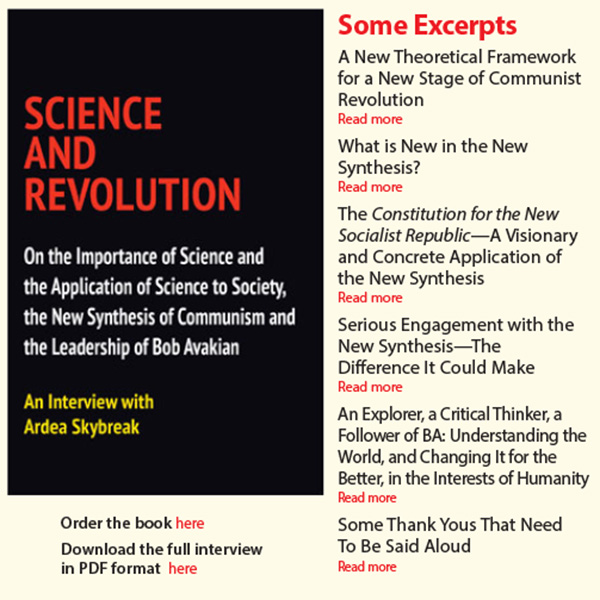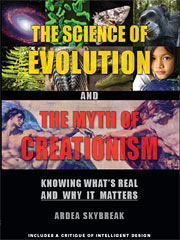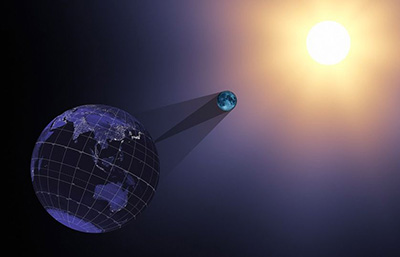The Total Solar Eclipse of 2017
A Cool Darkness that Shines Light on How Reality Works
August 17, 2017 | Revolution Newspaper | revcom.us
This coming Monday, August 21, the shadow of the moon will cross North America in about three hours, in a line from Oregon to South Carolina—a total solar eclipse. The complete shadow will be about a 70-mile-wide circle. Anyone in the path of that complete shadow will be able to watch as the moon’s shape moves completely in front of the sun, blocking out all the sun’s direct light. For someone standing still and looking up, this “totality” (when the sun is completely blocked out) will last less than three minutes. Outside this complete shadow you would still see the moon passing in front of part of the sun. Along with the parts of North America that are not in the path of the total eclipse, parts of South America, Africa, and Europe will be able to view a partial eclipse. Watch the video on the right to see how this works. Click here to view a map of Monday’s eclipse, and the times it will pass over your location. A search online can easily give more information.
A “total solar eclipse” is when the sun is completely blocked, “eclipsed,” by the moon. A “partial solar eclipse” is when only part of the sun is blocked by the moon. This is different from a lunar eclipse, when the moon is on the opposite side of the Earth from the sun and passes through the Earth’s shadow. A total solar eclipse happens somewhere on Earth about every 18 months. Most of these are over water and only a few people get to see them. The eclipse on August 21 this year is rare because it will mostly be over land, and millions will be able to watch. And it is an awesome sight! If you are completely in the shadow (seeing a total eclipse), the sun will become completely blocked out and for a few minutes it will look and feel like nighttime. You will even see some stars.
But that’s not all. If you’re completely in the moon’s shadow, you will see the sun’s outer fiery atmosphere, something impossible to see any other time because of the intensity of the sun’s light. It will look something like the picture at right.
Scientists are excited. Along with a wondrous awe (one scientist was quoted saying “It will be awe-inspiring and I mean that ‘awe’ in the original, moving you to tears since of ‘awe’”), they are gearing up to learn everything they can from this eclipse, including by popularizing experiments for “citizen scientists” (anyone who wants to get in on this) to do and send in results. Studying the sun during eclipses is not new, but there is still a great deal we don’t know. The sun is our star. It’s large enough that about one million Earths could fit in it. It’s more than 90 million miles from us. The moon is smaller than Earth, but because it’s much closer to us casts a shadow on the Earth’s surface when it passes in front of the sun. During a total eclipse, scientists can study the outer atmosphere of the sun. And through that they’ll learn even more about how our sun works, how stars work. Other scientists have experiments ready to learn how the Earth’s atmosphere and environment changes when radiation from the sun changes. Eleven satellites, high-altitude balloons, hundreds of ground-based telescopes and the International Space Station will be chasing the moon’s shadow.
These days we can also watch the moon’s shadow from space!
On Monday, humanity gets another peek at the awesomeness of the universe we are part of, how it works and our place in it. And it’s a chance to send a big “fuck you!” to those that would deny science and reality. Learning science, learning how to know what’s real, what’s true, discovering what we do not yet know, learning how to apply that to changing our world... this makes all the difference in the world.
It’s easy to find online videos and information about this eclipse, including what the science community is planning.
Science rocks!


The Science of Evolution and the Myth of Creationism
Knowing What's Real and Why It Matters
by Ardea Skybreak
"This book will be of tremendous benefit to many..."
— Richard Leakey
Volunteers Needed... for revcom.us and Revolution
If you like this article, subscribe, donate to and sustain Revolution newspaper.


